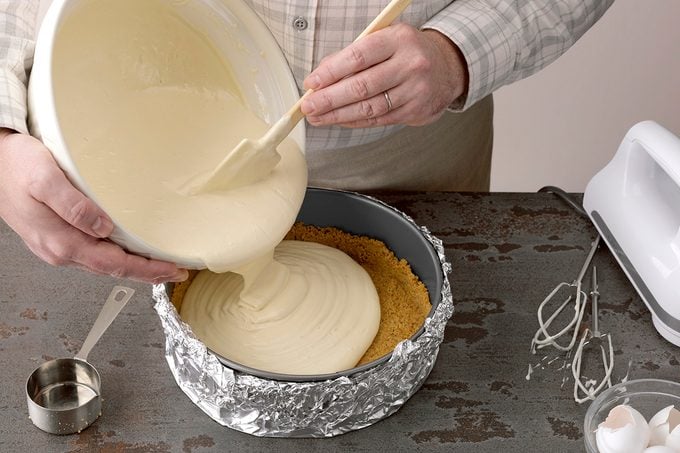How to Make Cheesecake from Scratch
Updated: Apr. 19, 2024

Want to learn how to make cheesecake? Our Test Kitchen has all the tips on how to make a great vanilla cheesecake—no cracks, no splits, just right. Plus, we've got tips on toppings!
A creamy, decadent cheesecake is the ultimate end to any meal. And learning how to make one yourself to punctuate your latest dinner party or get-together is an accomplishment. Now, cheesecake may seem finicky at first, but so long as you avoid some common cheesecake mistakes you’ll have a showstopping dessert that all your guests will be talking about.
So text all your pals to tell them to stop over for dinner and dessert, then start in on this how to make cheesecake tutorial. We’ll walk you through how to make a basic vanilla cheesecake—then you can use the same techniques to make whatever kind you please, like rich chocolate cheesecake or even fresh, fruity options.
How to Make Cheesecake from Scratch
To learn how to make cheesecake at home, it’s a good idea to start with a simple (but tasty recipe) like this five-star vanilla cheesecake. To make it you’ll need a few basic ingredients.
For the crust:
- 2 cups graham cracker crumbs
- 1/2 cup butter, melted
- 1/4 cup sugar
For the filling:
- 4 packages (8 ounces each) cream cheese, softened
- 1-1/2 cups sugar
- 3 tablespoons vanilla extract
- 1/8 teaspoon salt
- 4 eggs, room temperature, lightly beaten
Step 1: Prep Your Pan

To bake a cheesecake, you’ll want to invest in a springform pan. Our Test Kitchen loves our Taste of Home springform pan (obviously!).
Before you bake, though, you have to prep the pan. Start by wrapping the outside of the pan with foil to help prevent leaks—yes, even if the pan says leak-proof. This foil is your insurance policy. You don’t want any batter leaking out during baking.
Also give the pan a quick spritz of nonstick cooking spray—yes, even if the pan is nonstick. This coating of spray will make the cake easier to remove from the pan later.
Step 2: Make the Crumb Crust

Making a crumb crust is easy to do and it’s a handy skill to have for all sorts of desserts. To make the graham cracker crust, just stir together the crumbs, melted butter and sugar. Then press the mixture into the bottom of your springform pan until it holds firm. A flat-bottomed measuring cup or glass helps create an even crust.
Pop the crust into a 325ºF oven for 10 minutes just to set up a bit. Remove from the oven and cool on a wire rack while you work on the cheesecake filling.
Editor’s tip: You can experiment with crumb crusts. Cookies, pretzels, nuts and more all make great alternative crusts.
Step 3: Stir up the Cheesecake Batter

Next, stir up the basic cheesecake batter. Start by beating the cream cheese and sugar together until smooth. You’ll definitely want to use a hand mixer or stand mixer here to get the creamy texture you need. Then add in the salt and vanilla.
Finally, beat in the eggs. Stir until just combined. You don’t want to overbeat eggs in cheesecake batter. When you beat the eggs for an extended period, you add more air into the batter and an airy batter can cause the cheesecake to crack (no one wants that).
Pour the batter into the cooled crumb crust and get ready to bake.
Step 4: Bake in a Water Bath
To bake a crack-free cheesecake, use a water bath. A water bath is a simple technique that helps prevents cracks and bakes the cake more evenly. Make a water bath by placing the cheesecake into a high-sided pan (a roasting pan works great). Then fill the pan up an inch or so with hot—nearly boiling—water.
Bake at 325ºF for 55 to 60 minutes—until the center is almost set. You can tell a cheesecake is done with the center wobbles slightly when the side of the pan is tapped with a spoon. If the cake ripples like the surface of a pool, it needs more time.
While the wobble might seem to indicate that the cake isn’t quite done, the residual heat will cook the cake the rest of the way once it’s out of the oven.
Editor’s tip: An overbaked cheesecake is more likely to crack. Here are tips on how to avoid a cracked cheesecake and what to do if it does happen (it happens to the best of us!).
Step 5: Cool and Serve

When the cake is done, let it cool on a wire rack. After 10 minutes, take a dull knife and run it around the outside of the pan to loosen the cake. You don’t want any of the cake to stick to the edges while it cools. A stuck cake can crack as the cake cools and contracts.
Cool the cake another hour and move the refrigerator for an overnight stay. The following day, take off the springform collar and let it sit at room temperature for about 20 minutes before serving. To get picture-perfect slices, dip a sharp knife into hot water, wipe dry and then cut. This will give you clean, gorgeous slices.
Optional (But Highly Encouraged): Toppings
This vanilla cheesecake is delicious on its own thanks to a dose of vanilla extract, but you can always layer on more flavors. Fresh fruit is always a welcome topper for cheesecake as is homemade whipped cream, rich chocolate ganache or even a tasty raspberry sauce. You could even combine a few of these for an over-the-top dessert all your friends will love.
Hungry for More?
Don’t forget to stock up on cheesecake baking gear as well as these cheesecake baking tips from our Test Kitchen.


















